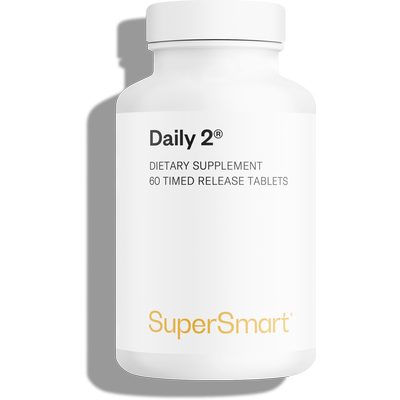24-01-2018
Prolonged-release supplements: how do they work?
 There are still relatively few of these on the market, though some, such as Daily 2© are already very popular. We’re talking about prolonged, delayed or slow-release supplements. They work like standard supplements except for one fundamental difference: they’re designed to gradually release their active principles.
There are still relatively few of these on the market, though some, such as Daily 2© are already very popular. We’re talking about prolonged, delayed or slow-release supplements. They work like standard supplements except for one fundamental difference: they’re designed to gradually release their active principles. In standard supplements, the active principles are all released simultaneously from the capsule or tablet at the intended site (the gastrointestinal tract, for example). Thus the vitamin C in a regular supplement will be released once the capsule has been dissolved by the body’s gastric fluids. It’s only after this that it migrates to and crosses biological barriers to be absorbed by the body1.
In the case of prolonged-release supplements, the tablet or capsule does not release the active principles all at once. So instead of being confronted with a huge influx of compounds to absorb, the body receives a steady stream of the substance, in a way that mimics natural conditions. If we take the example of Daily 2©, the 32 nutrients in each capsule are slowly dispersed over several hours. As a result, there’s no peak plasma concentration of active molecules but instead a steady concentration over time.
How does this gradual release happen?
How is this achieved? A number of ways are currently used, one of the most popular of which is based on a matrix in which the active principles are embedded.
Put simply, the active principles are evenly dissolved in a molecular state or dispersed as particles in a base. This base usually takes the form of a porous network designed to resist disintegration: stomach acids and digestive enzymes are thus unable, or almost unable, to break it down2-3. There’s only one way in which the active principles can break free: wait for water to slowly infiltrate the base at which point they are dissolved and discharged along with the water.
Some of these bases are made of inert material (ie, mineral or plastic) while others, such as in the case of Daily 2©, are composed of gelatinous material. The active principles are carefully blended with a gelling agent (a hydrophilic polymer), which starts to swell as soon as it comes into contact with gastric fluids. The resulting gel coating encases the active principles and prevents them from being released immediately in the body.
What are the benefits offered by prolonged-release supplements?
Have you noticed how naturally, certain micronutrients never arrive in the body in huge amounts?
Vitamin D, for example, is produced by the body from the sun’s UVB rays at maximum levels of 15,000-20,000IU a day, at a continuous rate, while vitamin D from dietary sources never delivers more than 1000IU at any one time4. Despite that, and on the grounds that the body is able to store vitamin D, many practitioners prefer to recommend mega-doses of the vitamin (we’re talking 100,000IU in one dose, every three months) on the basis that it’s easy to miss a daily dose, or forget to take it altogether. Yet many studies show that when it’s delivered on a continual basis, vitamin D is more effective5 and safer for children, and in particular, the elderly6 (administration of high-dose vitamin D has been associated with an increased risk of falls7, and more marked functional decline8). Very high doses of vitamin D may increase concentrations of molecules such as FGF23 and sclerostin, implicated in osteoporosis9-10.
This applies even more to the B vitamins and vitamin C, as the body rapidly eliminates surplus amounts it can’t absorb, as well to calcium where it’s essential to spread daily intake across several doses for optimal absorption.
With prolonged-release supplements, you can thus gain long-lasting benefits from the synergy created between micronutrients and minerals. There are three main advantages to taking multivitamins in this form:
- Preventing peak plasma concentrations associated with a risk of unwelcome effects from certain compounds.
- Prolonging the effect of the active principles over time: a momentarily high antioxidant plasma concentration is not as good as a more moderate but steady antioxidant concentration.
- Reducing the number of daily doses necessary: those who are well-informed about micronutrient absorption know that some are better absorbed when taken in several doses of lower amounts. But taking numerous tablets throughout the day seems somewhat tedious when you can take one tablet that offers prolonged-release of these micronutrients. It’s also an easier way to establish a habit and ensure you adhere to regular supplementation.
References
1. Siepmann, J., F. Siepmann, and T. Florence Alexander, Factors Influencing Oral Drug Absorption and Drug Availability, in Modern pharmaceutics. p. 117-154.
2. Brossard, C., les formes galéniques orales matricielles in Actualités Pharmaceutiques. 2000. p. 46-48.
3. J. L. Salomon and E. Doelker, Formulation des comprimes à libération prolongée I. Matrices inertes., in Pharm. Acta Helv. 1980. p. 174-182.
4. Food and Nutrition Board, Institute of Medicine. Dietary Reference Intakes for Calcium, Phosphorus, Magnesium, Vitamin D, and Fluoride. Washington, DC: National Academy Press, 1999. Available at: http://books.nap.edu/books/0309063507/html/index.html.
5. Pekkarinen T., Valimaki V.-V., Valimaki M.J. The same annual dose of 292000 IU of vitamin D3 (cholecalciferol) on either daily or four monthly basis for elderly women: 1-year comparative study of the effects on serum 25(OH)D3 concentrations and renal function. Clin. Endocrinol. 2010;72:455–461. doi: 10.1111/j.1365-2265.2009.03637.x.
6. Dalle Carbonare L, Valenti MT et al. Vitamin D: Daily vs. Monthly Use in Children and Elderly-What Is Going On ? Nutrients. 2017 Jun 24;9(7). pii: E652. doi: 10.3390/nu9070652.
7. Sanders KM, Stuart AL, Williamson EJ, Simpson JA, Kotowicz MA, Young D, Nicholson GC. Annual high-dose oral vitamin D and falls and fractures in older women: a randomized controlled trial. JAMA. 2010 May 12; 303(18):1815-22.
8. Bischoff-Ferrari HA, Dawson-Hughes B, Orav EJ, Staehelin HB, Meyer OW, Theiler R, Dick W, Willett WC, Egli A. Monthly High-Dose Vitamin D Treatment for the Prevention of Functional Decline: A Randomized Clinical Trial. JAMA Intern Med. 2016 Feb; 176(2):175-83.
9. Sankaralingam A., Roplekar R., Turner C., Dalton R.N., Hampson G. Changes in dickkopf-1 (DKK1) and sclerostin following a loading dose of vitamin D2 (300,000 IU) J. Osteoporos. 2014;2014:682763. doi: 10.1155/2014/682763.
10. Turner C., Dalton N., Inaoui R., Fogelman I., Fraser W.D., Hampson G. Effect of a 300,000 IU loading dose of ergocalciferol (vitamin D2) on circulating 1,25(OH)2-vitamin D and fibroblast growth factor-23 (FGF-23) in vitamin D insufficiency. J. Clin. Endocrinol. Metab. 2013;98:550–556. doi: 10.1210/jc.2012-2790.
Order the nutrient mentioned in this article
Further reading
06-12-2017
The subject of extensive research in recent years, gut flora is now recognised as playing many roles within the body. Yet studies increasingly warn of...
Read more28-03-2018
Packet soups, reconstituted ham, tasteless ready-meals full of additives, desserts mega-sweetened with powdered milk… Within a few decades, our grandchildren will be astonished by what...
Read more08-11-2017
What better time to adopt a more environmentally-friendly diet than November – World Vegan Month. Characterised by the rejection of animal source foods, veganism is...
Read more© 1997-2025 Fondation pour le Libre Choix
All rights reserved
All rights reserved
Free
Thank you for visiting our site. Before you go
REGISTER WITHClub SuperSmart
And take advantage
of exclusive benefits:
of exclusive benefits:
- Free: our weekly science-based newsletter "Nutranews"
- Special offers for club members only


















